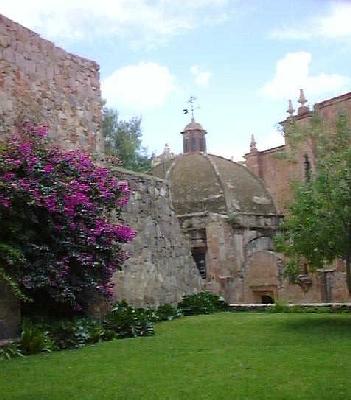
Zacatecas, Mexico
Part one - the town

View of Zacatecas from the Pedro Coronel Museum
Friday 20th August - Tuesday 23rd August 1999
We arrived in Zacatecas "fresh" from a 12-hour overnight bus journey from Chihuahua which, thanks to the reconstruction of a section of the "highway" was extremely uncomfortable in parts, as the bus driver seemed determined to break the land speed record for buses on dirt tracks. Still, we made it in one piece to the city centre, and found the Hotel Rio Grande readily enough. The only problem was that our room was not yet ready. However, the very friendly lady at reception allowed us to store our luggage behind the desk so we could go for a coffee and some breakfast until our room was ready. In the meantime, I had lost my big floppy hat which I'd bought in Sarajevo (sob sob).
Zacatecas itself is a charming town, the old centre of which was proclaimed a World Heritage Site by UNESCO a few years ago, and deservedly so. The people of the town (some of them at any rate) made huge fortunes from the nearby silver mine which, thanks to slave labour on the part of the local Indians, produced some 20% of the world's silver for around 250 years. Much of the money thus generated went into art and architecture, and the old town is beautiful if a bit dirty. In particular, the cathedral, which dominates the main city square, is a spectacular example of Mexican baroque, and the main façade is simply stunning.

Zacatecas Cathedral
The town is built around two main streets, Hidalgo and Juarez, but some of the most interesting spots are located in the little narrow side streets. The setting of the town is spectacular, although rapid growth on the outskirts of the city in recent years has spoiled this somewhat. Overlooking the town is an oddly shaped hill which dominates the horizon and which can be reached by a cable car. We didn't make it up there though.

Narrow street in Zacatecas
We did make it to the Pedro Coronel Museum. Coronel was one of Mexico's leading artists who lived and studied in Europe and North America, building a fine collection of artworks from all over the world. When he died, he left his collection to the people of Zacatecas, who established a fine museum in the buildings of the old Jesuit college in the town. The building itself is very attractive, and the collection is eclectic and excellent. A particular highlight for me was the astonishing collection of masks, many from Mexico, both pre-Columbian and colonial, and others from around the world, especially Africa (Nigeria, Cote d'Ivoire, Congo) and Indonesia. The museum also contains a small collection of classical Roman and Greek sculpture, some interesting Asian religious works (China, Tibet and India mainly) and a small but diverse collection of European art, with works by Picasso, Kandinsky and Miro, to name but a few. The collection lacks a little in coherence being so wide-ranging, but it certainly makes for an interesting afternoon.

Rooftop garden at the Pedro Coronel Museum
Next | Mexico index | Travel index | Family history | Romany | Main index